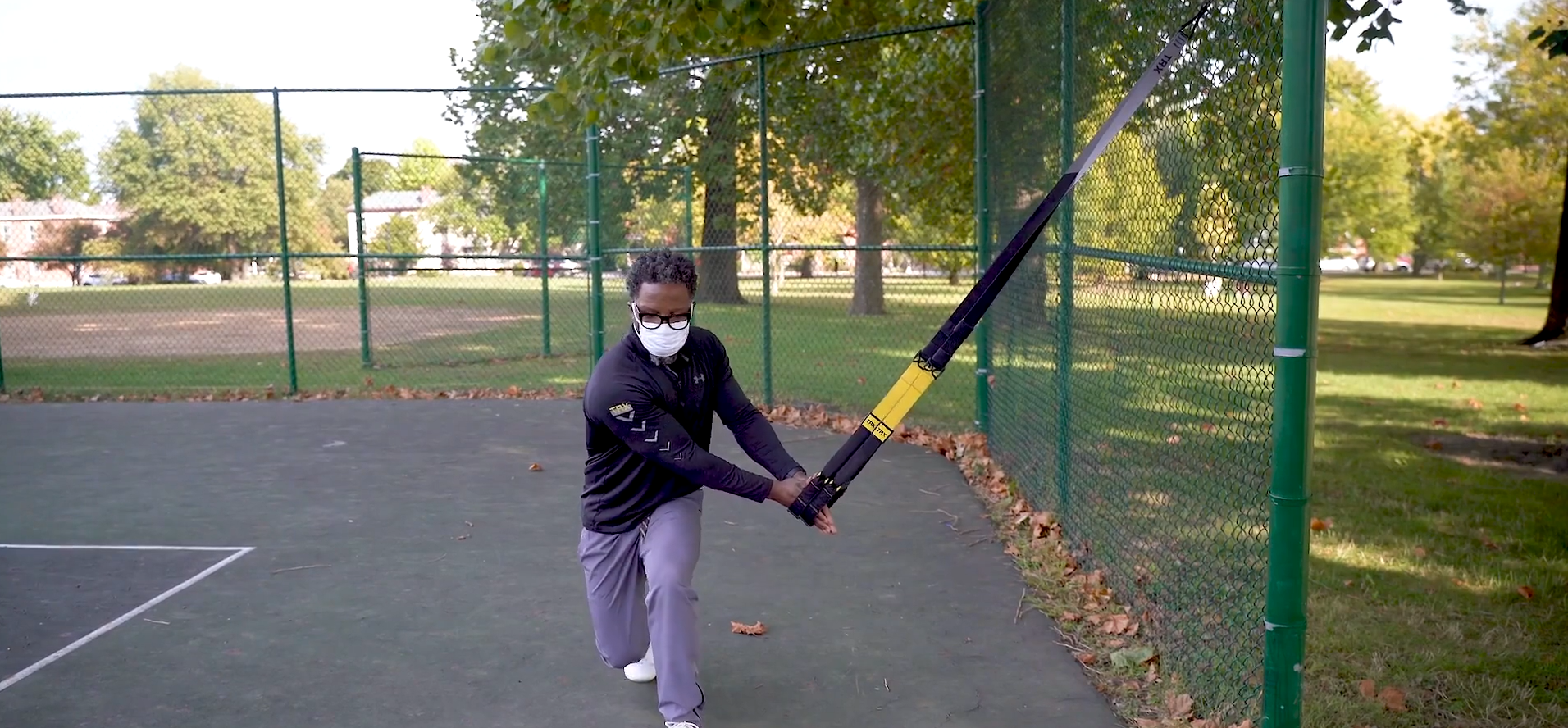Everyone knows about foam rolling these days--it's so popular, it's showing up in the swim community, too. Why? Competitive swimming requires swimmers to train or compete on consecutive days, often under conditions of fatigue. This impacts a swimmer's ability to train hard or compete. Plus, it doesn't matter how strong and powerful a swimmer you are--if you don't have good range of motion in your joints and muscle flexibility, it's harder to achieve a streamlined position in the water. Using the TRX Rocker and other self-myofascial release tools could be an effective method for optimising training efforts.
LET'S TALK SELF-MYOFASCIAL RELEASE

Advocates of self-myofascial release propose that releasing tight myofascial tissue and fascia (translation: soft tissue that surrounds muscles, bones, organs, nerves, blood vessels and other structures) improves muscle function; if a muscle's function improves, then performance improves. How is that "release" achieved? Through the use of direct pressure.
The TRX Rocker's different heights and ridges offer an even more targeted approach to trigger points and tension release thanks to a unique design that a creates a rocking vs. rolling motion. It both stretches myofascial structures and generates friction, which helps to restore normal blood flow, improving muscle recovery.
To get an expert opinion, we spoke with David Parker-- Strength and Conditioning Coach to Swindon Dolphin ASC., and TRX Master Trainer--about the reasons why self-myofascial release tools, such as the TRX Rocker, make such an effective and vital recovery tool for competitive swimmers.
REASON #1: THEY INCREASE FLEXIBILITY

Flexibility is key for swimmers because drag will always trump power in the pool. The TRX Rocker and other self-myofascial release tools makes swimmers more flexible--plain and simple.
WHAT DOES THE SCIENCE SAY?
Paušić, Drušković and Todd (2014) demonstrated that after foam rolling one of the quadriceps muscles, the knee joint experienced an increased range of movement by approximately 11 and 9 degrees after 2 and 10 minutes, respectively.
The same researchers also looked at force production in the same muscle at 2- and 10-minutes post-rolling and concluded that foam rolling had no significant impact on quadriceps force or activation. This gives supporting evidence to the potential benefits of using the TRX Rocker to increase joint range of movement before a competition--without it affecting athletic activities that require substantial force production (like diving from the starting block).
Unfortunately, not all studies on foam rolling have reported a positive effect on flexibility. A study by Gotosky et al. (2015) concluded that foam rolling applied to the front of the thigh did not improve knee flexion range of movement. However, the research did state that two, one-minute bouts of foam rolling were performed after a thorough ten-minute dynamic warm-up,--it's possible that the study participants had already maximised their potential from the dynamic warm-up before administering the foam roller.
REASON #2: THEY IMPROVE RECOVERY

Fatigue from heavy training or new movements and intensity can cause discomfort or muscle soreness. This inflammation and impairment in muscle tissue function is called Delayed-Onset Muscle Soreness (DOMS). DOMS typically increases in intensity within the first 24 hours post-training and peaks between 24 and 72 hours before subsiding. DOMS substantially reduces training performance in athletes (Byrne C, Twist C, Eston R, 2004), however, foam rolling or using the TRX Rocker can aid recovery.
WHAT DOES THE SCIENCE SAY?
A study by McDonald et al. (2014) examined the effects of foam rolling on neuromuscular performance for up to 72 hours post-DOMS. The foam-rolling group had reduced muscle soreness and increased voluntary muscle activation, vertical jump height, and flexibility when compared with the control group (a "control group" is a benchmark group to which comparisons are made in an experiment).
Another study by Gregory et al., (2015) also had a control group and a foam rolling group. Both conditions were separated by four weeks, with both groups conducting a DOMS protocol to initiate DOMS--10 sets of 10 repetitions of a barbell back squat, performed at 60% of the participant's 1 repetition maximum, plus repetitive eccentric muscle contractions (lengthening of the muscle). The foam rolling protocol consisted of foam rolling the lower extremity muscle groups for both legs for 45 seconds followed by a 15 second rest.
The foam roll study participants were instructed to foam roll on three occasions post-DOMS protocol: 1) directly after, 2) 24 hours post-DOMS protocol, and 3) 48 hours post-DOMS protocol. The participants then performed a test to assess muscle tenderness of the quadriceps for both legs (the test is used to determine the minimal amount of pressure that causes pain--a higher pressure pain threshold indicates a smaller amount of muscle tenderness). When tested 24 and 48 hours post-exercise, the participants reported a decrease in quadriceps pain. The researchers concluded that foam rolling improved quadriceps muscle tenderness by a moderate to large amount in the days after fatigue.
OUR TAKEAWAY
Self-myofascial release using a foam roller appears to increase flexibility for up to 10 minutes post-application. The result suggests self-myofascial release tools, such as the TRX Rocker, can be used immediately before swim training and competition to increase flexibility.

Furthermore, there seems to be no adverse effect on performance. Another suggestion would be to use the TRX Rocker during swim training, especially when practising starts, turns and breakouts, all of which require you to maintain a strong, streamlined position. The TRX Rocker makes for an excellent addition to any swimmer's kit bag who are looking to improve their performance in the pool.
References:
Acute Effects of Deep Tissue Foam Rolling and Dynamic Stretching on Muscular Strength, Power, and Flexibility in Division I Linemen. Behara B, Jacobson BH. J Strength Cond Res. 2017 Apr; 31(4):888-892.
Roller massager improves range of motion of plantar flexor muscles without subsequent decreases in force parameters. Halperin I, Aboodarda SJ, Button DC, Andersen LL, Behm DG
Int J Sports Phys Ther. 2014 Feb; 9(1):92-102.
An acute bout of self-myofascial release increases range of motion without a subsequent decrease in muscle activation or force. MacDonald GZ, Penney MD, Mullaley ME, Cuconato AL, Drake CD, Behm DG, Button DC J Strength Cond Res. 2013 Mar; 27(3):812-21.
Is self-myofascial release an effective pre-exercise and recovery strategy? A literature review. Schroeder AN, Best TM. Curr Sports Med Rep. 2015 May-Jun; 14(3):200-8.
Neuromuscular function after exercise-induced muscle damage: theoretical and applied implications. Byrne C, Twist C, Eston R Sports Med. 2004; 34(1):49-69.
Foam Rolling for Delayed-Onset Muscle Soreness and Recovery of Dynamic Performance Measures. Gregory E. P. Pearcey, MSc,* David J. Bradbury-Squires, MSc,* Jon-Erik Kawamoto, MSc,* Eric J. Drinkwater, PhD,*€ David G. Behm, PhD,* and Duane C. Button, PhD* 2015
Terminology Used in Fascia Research. Journal of Bodywork and Movement Therapies, Volume 12 , Issue 3 , 204 - 212
Foam rolling as a recovery tool after an intense bout of physical activity. Macdonald GZ, Button DC, Drinkwater EJ, Behm DG Med Sci Sports Exerc. 2014 Jan; 46(1):131-42.
Weerapong P, Hume PA, Kolt GS. The mechanisms of massage and effects on performance, muscle recovery and injury prevention. Sports Med. 2005;35(3):235€“256.
An acute bout of self-myofascial release increases range of motion without A subsequent decrease in muscle activation or force. Graham z. Macdonald, michael d.h. Penney, michelle e. Mullaley, amanda l. Cuconato,
Corey d.j. Drake, david g. Behm, and Duane c. Button Paušić, Jelena, Drušković, Petra, Todd, Jeremy 2014
DOES THE USE OF FOAM ROLLER HAS AN INFLUENCE ON RECTUS FEMORIS ELONGATION? 10.13140/2.1.1539.8722



